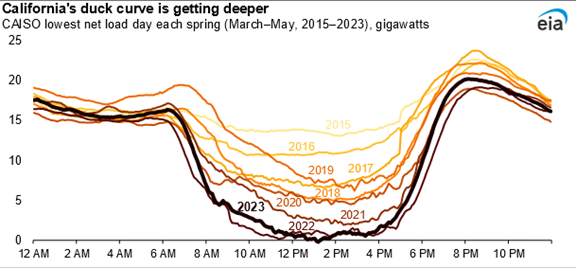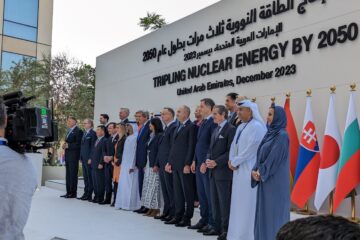The California Duck Curve gets deeper – the challenges of high levels of intermittent variable renewable energy
A recent article caught our eye – “Stanford study warns against overnight charging of electric cars at home” in California. This study noted that most electric vehicle (EV) owners tend to charge their vehicles at home during the evening or overnight (which should come as no surprise to anyone), leading to significant costs for the electricity grid as California relies more and more on solar energy. It projects the rapid growth of EVs and their reliance on nighttime charging could lead to a 25% increase in peak electricity demand within a little over a decade. This study’s solution, get people to shift towards daytime charging at public charging stations or workplaces. It goes on to explain that “if more people charged their vehicles during the day at work or public charging stations, it could reduce greenhouse gas emissions (presumably by avoiding gas usage at night) and avoid the added costs of generating and storing electricity”.

This is the beginning of an awareness of what happens when you rely too much on intermittent variable renewables for your electricity needs. It forces you to use the electricity when the sun shines (in this case) or the wind blows, which is not necessarily when you actually need it.
California has had this issue for years. Due to a rapidly increasing amount of solar electricity, the net load on the system (total load less renewables) reduces rapidly in the morning when the sun comes up and solar power comes online, then increases again as the sun goes down and solar drops off. This has come to be known as the “Duck Curve”, as the shape of the curve looks like a duck! What we see below is that the depth of the curve has continued to get deeper over the last eight years as California adds more and more solar power.

Don’t get us wrong, we like solar especially in sunny locations like California. Generally, solar plants produce about 15 to 20% of the time depending on location (based on the level of sunshine). Well, in very sunny California, the average capacity factor for solar is just over 28%. Excellent for this type of generation. This clearly has an important role to play in the generation mix.
But we also see that too much of a good thing can create new challenges. The cost to the system of being able to accommodate this rapid change in load when the sun comes up and again when it goes down is large. Storage and other dispatchable sources of electricity (likely gas) are required to meet the needs the 70% of the time the sun is not shining. The duck curve also reduces the amount of time dispatchable conventional power plants operate, reducing their revenues, making them less economic to operate in the California market. If these plants are then retired without replacement, it becomes even harder to meet the needs of the system.
The other issue is grid stress. Grid operators need to drastically ramp up non solar generation as the sun sets, a very difficult thing to do. In the past, when we considered how big of a single generating plant a system could accommodate, we often used a simple rule of thumb that no unit should be larger than 10% of the entire system. Larger than that, the ability of the system to manage a unit outage would be compromised putting system reliability at risk. That is what solar has become in California. While you may think that there are many solar units in place, due to their intermittency, they operate on the system as one extremely large plant. They all come on at the same time when the sun comes up and they all go off at the same time when the sun goes down. What is the system to do?
We had a wonderful vacation in southern California this past July. Spent some time in Palm Springs where the temperatures were on the order of 45 to 47 degrees Celsius (~115 degrees Fahrenheit). I can assure you that we needed air conditioning as much at night as during the day.
Now imagine what would happen without having the back up needed. Storage is part of the solution but requires a huge overbuild of daytime capacity to both meet the day’s energy needs while also filling storage for other times. And mostly current storage technology is good for hours, not days or weeks creating issues for when the weather is simply not cooperating (two weeks of continuous rain for example) or to meet seasonal load changes. The result is a growing consensus that firm dispatchable capacity also needs to be an essential part of any clean energy solution.
The Diablo Canyon nuclear plant in California produces energy about 90% of the time, in other words each MW of capacity of California nuclear produces more than 3 times the amount of energy in a year than the equivalent capacity of solar. That is what builds a resilient system.
I don’t have an electric vehicle yet, but when I do, I will definitely feel better knowing I can leave home in the morning with a full charge.





5 Comments
Steve Kidd · August 21, 2023 at 4:37 pm
At least there’s some predictability about solar in California, which holds out the possibility of storage eventually covering the low points. We know, for example, that output will be lower in winter than summer owing to (a) fewer daylight hours (b) the sun being less intensive with lower elevation and (c) more cloud cover. By contrast, wind power is much more unpredictable and low points more problematical to cover. California’s renewable energy experiment arguably therefore makes more sense than the craziness we’re attempting in UK and NW Europe.
Sharon · August 21, 2023 at 5:27 pm
Excellent blog this time , good info
Ian Grant · August 21, 2023 at 9:34 pm
Excellent insights!
bruce macdonald · August 28, 2023 at 9:16 am
Excellent article. As always: logical and very though provoking.
Bruce
Robert Ion · August 28, 2023 at 9:29 am
Very informative. Thank you!
Comments are closed.